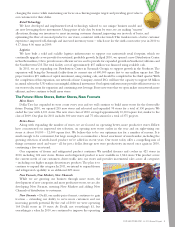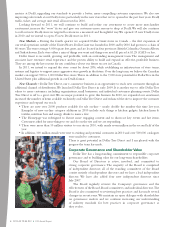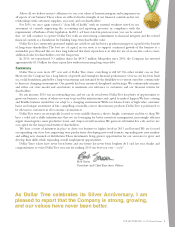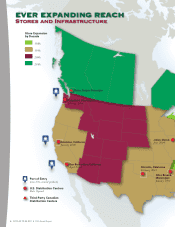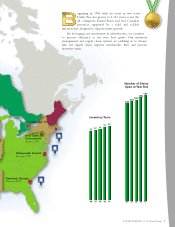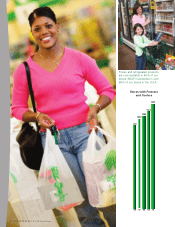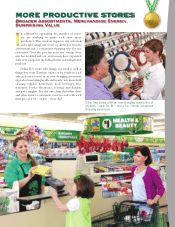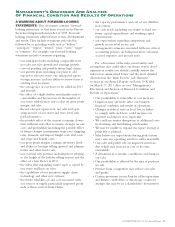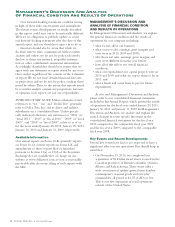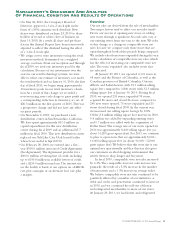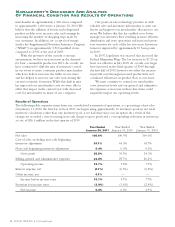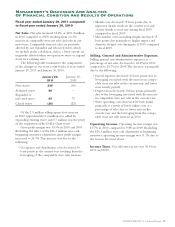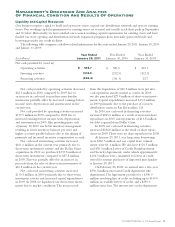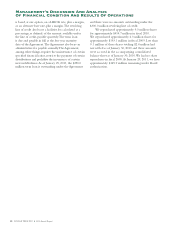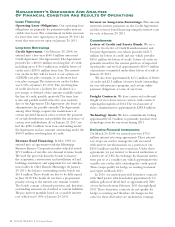Dollar Tree 2010 Annual Report Download - page 15
Download and view the complete annual report
Please find page 15 of the 2010 Dollar Tree annual report below. You can navigate through the pages in the report by either clicking on the pages listed below, or by using the keyword search tool below to find specific information within the annual report.Management’s Discussion And Analysis
Of Financial Condition And Results Of Operations
A WARNING ABOUT FORWARD-LOOKING
STATEMENTS: This document contains “forward-
looking statements” as that term is used in the Private
Securities Litigation Reform Act of 1995. Forward-
looking statements address future events, developments
and results. They include statements preceded by,
followed by or including words such as “believe,”
“anticipate,” “expect,” “intend,” “plan,” “view,” “target”
or “estimate.” For example, our forward-looking
statements include statements regarding:
• our anticipated sales, including comparable store
net sales, net sales growth and earnings growth;
• costs of pending and possible future legal claims;
• our growth plans, including our plans to add,
expand or relocate stores, our anticipated square
footage increase, and our ability to renew leases at
existing store locations;
• the average size of our stores to be added in 2011
and beyond;
• the effect of a slight shift in merchandise mix to
consumables and the increase in the number of
our stores with freezers and coolers on gross profi t
margin and sales;
• the net sales per square foot, net sales and oper-
ating income of our stores and store-level cash
payback metrics;
• the possible effect of the current economic down-
turn, infl ation and other economic changes on our
costs and profi tability, including the possible effect
of future changes in minimum wage rates, shipping
rates, domestic and import freight costs, fuel costs
and wage and benefi t costs;
• our gross profi t margin, earnings, inventory levels
and ability to leverage selling, general and adminis-
trative and other fi xed costs;
• our seasonal sales patterns including those relating
to the length of the holiday selling seasons and the
effect of a later Easter in 2011;
• the effect that expanding tender types accepted by
our stores will have on sales;
• the capabilities of our inventory supply chain
technology and other new systems;
• the future reliability of, and cost associated with,
our sources of supply, particularly imported goods
such as those sourced from China;
• the capacity, performance and cost of our distribu-
tion centers;
• our cash needs, including our ability to fund our
future capital expenditures and working capital
requirements;
• our expectations regarding competition and
growth in our retail sector; and
• management’s estimates associated with our critical
accounting policies, including inventory valuation,
accrued expenses, and income taxes.
For a discussion of the risks, uncertainties and
assumptions that could affect our future events, devel-
opments or results, you should carefully review the
risk factors summarized below and the more detailed
discussion in the “Risk Factors” and “Business”
sections in our Annual Report on Form 10-K fi led
on March 17, 2011. Also see our “Management’s
Discussion and Analysis of Financial Condition and
Results of Operations.”
• Our profi tability is vulnerable to cost increases.
• Litigation may adversely affect our business,
fi nancial condition and results of operations.
• Changes in federal, state or local law, or failure
to comply with such laws, could increase our
expenses and expose us to legal risks.
• We could encounter disruptions or additional costs
in obtaining and distributing merchandise.
• We may be unable to expand our square footage as
profi tably as planned.
• Sales below our expectations during peak seasons
may cause our operating results to suffer materially.
• Our sales and profi ts rely on imported merchan-
dise, which may increase in cost or become
unavailable.
• A downturn in economic conditions could impact
our sales.
• Our profi tability is affected by the mix of products
we sell.
• Pressure from competitors may reduce our sales
and profi ts.
• Certain provisions in our Articles of Incorporation
and Bylaws could delay or discourage a takeover
attempt that may be in a shareholder’s best interest.
DOLLAR TREE, INC. ♦ 2010 Annual Report 13


